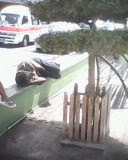Whilst reading my colleagues' blogs, I was so happy to see how such relevant urban subjects were interrelated. I have learnt a lot thus far about my theme, and have read much scholarly articles regarding the topic of homelessness. While this indeed may be my last post, it certainly not is the end. Becoming engaged in this blogging activity has aroused and deepened my interest in the topic, and I will continue to keep myself well informed about homeless persons, especially in the Global South. Any articles or links I see interesting I will share on this space. But I would also like to share what my colleagues have done regarding my blog.
- Kevin Ousman's blog, themed "Urbanosity," revealed how a newly urbanized Trinidad affects the behaviors of citizens, both in a positive and negative light. Unfortunately, with regard to homelessness, the reactions seemed to be negative, according to Ousman's post "Homeless: Sweep Them Under The Rug?" So true his words were when he said that urban dwellers misconceive homeless persons as "how yuh make yuh bed so yuh lie" and truthfully viewed as an eye sore.
- On as side point, Ousman also furthered my post on "Accommodations" in his post "De Bandit Mentality" where defensive architecture was featured in his picture choice, but this time not against homeless persons, but against..well... bandits! It really brought to mind the questions of the readiness of Trinidad taking a step forward in calling itself post-modern.
- Nirvana Hanooman also gave her take on homelessness in two of her posts, one entitles "Homelessness-No where to go" and "A place to call home :-)" The information she presented was insync with my points. For example, while including her personal experience, she stated that housing is an important determinant of personal security and comfort, however it is clear that the ability of persons to secure a home is unequal throughout the city. Very important was the point that homelessness is caused by a diverse variety of reasons.
- Conversely, where I lacked, Tabeeta Dwarika filled in. In her post "Decentralization- Good or Bad?" Dwarika stated as a solution to homefullness (if I may) was decentralization, giving the Trincity Millennium Vision as an example of such. Such a post was really appreciated as the concept of family and community was encouraged, something gravely lacking in the homeless arena. This was highlighted in my post "House vs. Home."
Fellow bloggers, thank you sincerely for taking you time to read my posts, and as an end, I'll just leave with this song...



.jpg)
.jpg)



.jpg)



